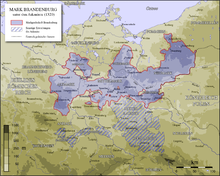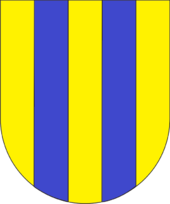Mark Landsberg
The Mark Landsberg , also Margraviate Landsberg , emerged in the 13th century through the division of inheritance from the westernmost part of the Mark Lausitz , which was part of the Saxon East Mark until 965 . Along with the margraviate of Meißen, it is considered the home of the Wettins . It encompassed a not precisely defined area between the lower Saale and the Elbe . The focal point was the protruding mountain, which used to be a Slavic castle. The name of the castle and the town of Landsberg in today's Saalekreis goes back to this mountain .
After the division of the Wettin countries by Konrad, Margrave of Meißen and Lausitz in 1156, his son Dietrich, Margrave of Lusatia , to whom this part fell, began building the castle in 1170. This was completed in 1174, and Dietrich also carried the title of "Margrave of Landsberg", but this does not imply an independent state.
It was not until the Meissen and Lusatian Margrave Heinrich the Illustrious created an independent imperial territory Landsberg (Mark Landsberg) for his younger son Dietrich in 1261, against existing imperial law, which also included the city of Leipzig, which was supported by this. After the death of his son Friedrich , the land fell to Albrecht the Degenerate . In 1291 the Landsberg mark was sold to the Brandenburg Ascanians , but was returned to the Wettins in 1347.
The Landsberg stakes were the coat of arms of the Mark Landsberg . Two blue stakes on a gold (yellow) background have been the family crest of the Wettin margraves since the end of the 12th century. a. in the city arms of Leipzig , Chemnitz and Dresden (here tinged in black ).
literature
- Stefan Auert-Watzik, Henning Mertens (eds.): Peripheries of Saxon history. Central Germany, Seeburg and Landsberg as rulership and cultural areas of the Ekkehardines and Wettins 936–1347. (= Contributions to Landsberg Regional History, Vol. 1. ) Landsberg 2011, ISBN 978-3-940744-43-2 .

